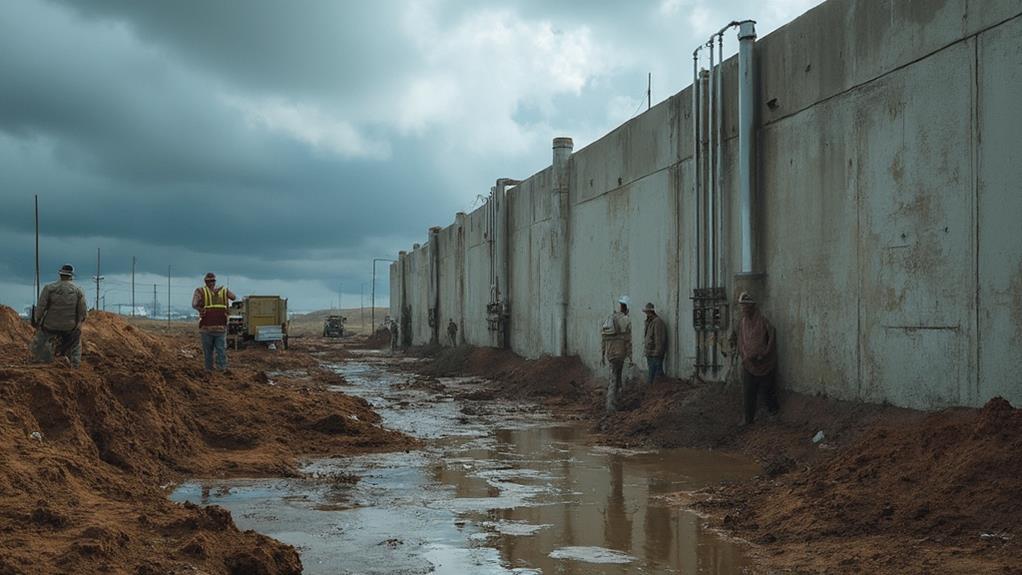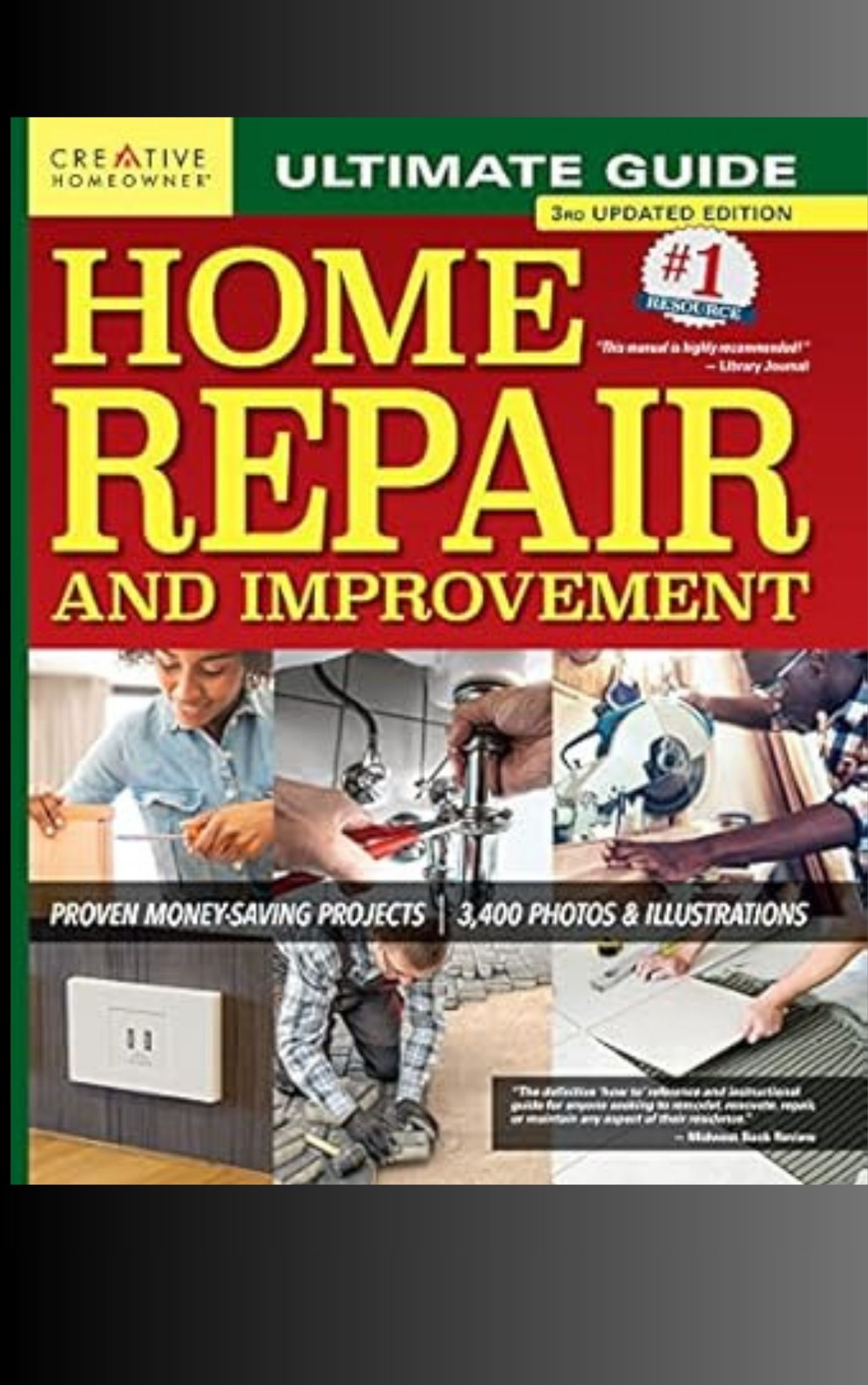Recent storm patterns have exposed critical vulnerabilities in traditional foundation waterproofing methods. Increased frequency and intensity of heavy rainfall events, coupled with prolonged dry spells, are challenging existing waterproofing strategies. Modern techniques now focus on comprehensive solutions, including exterior membrane systems, crystalline waterproofing compounds, and advanced drainage solutions. Proper landscaping, interior moisture control, and regular maintenance of sump pumps are essential. Homeowners must also consider climate-resilient foundation designs that incorporate elevated structures, reinforced footings, and water-resistant materials. By adopting these lessons, property owners can better protect their foundations against evolving weather patterns and minimize long-term damage.
Understanding New Storm Patterns
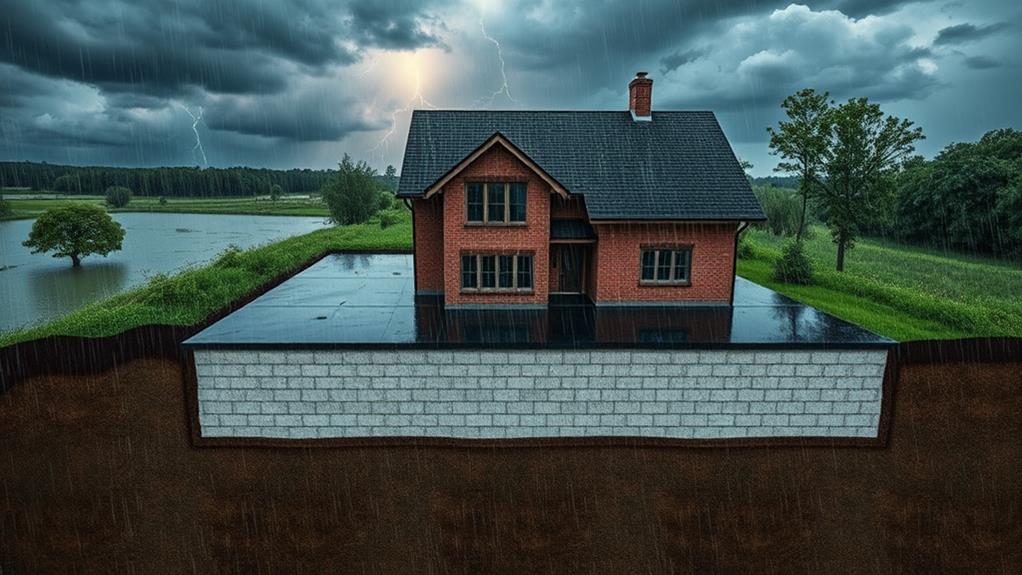
Many regions are experiencing significant shifts in storm patterns due to climate change. These changes include increased frequency and intensity of heavy rainfall events, prolonged dry spells followed by sudden downpours, and alterations in seasonal precipitation patterns. Such shifts can have profound implications for foundation waterproofing strategies.
Traditional waterproofing methods may no longer suffice in areas now experiencing more severe storms. For instance, regions previously reliant on basic exterior sealants might now require more robust systems, such as interior drainage or exterior waterproofing membranes. Additionally, the unpredictability of new storm patterns necessitates a more proactive approach to foundation maintenance and protection.
Understanding these evolving patterns is crucial for homeowners and contractors alike. It involves analyzing local climate data, staying informed about regional weather trends, and consulting with meteorologists or climate scientists. This knowledge can inform decisions about the type and extent of waterproofing measures needed, as well as the timing of installations or upgrades. By anticipating and preparing for these new storm patterns, property owners can better protect their foundations from water damage and ensure long-term structural integrity.
Foundation Vulnerabilities Exposed
As new storm patterns emerge, they often expose previously hidden vulnerabilities in building foundations. These vulnerabilities can manifest in various ways, including cracks, leaks, and structural instability. The increased frequency and intensity of extreme weather events have highlighted weaknesses in traditional waterproofing methods, particularly in older structures.
One common vulnerability is inadequate drainage systems, which can lead to water accumulation around the foundation. This excess moisture can seep through tiny cracks or porous concrete, causing damage over time. Another issue is the deterioration of waterproofing materials due to prolonged exposure to harsh environmental conditions. Additionally, improper grading around the building can direct water towards the foundation instead of away from it.
Foundation settling, a natural process exacerbated by changing soil moisture levels, can create gaps and cracks that allow water intrusion. Hydrostatic pressure, caused by saturated soil pushing against foundation walls, can lead to structural damage if not properly addressed. These vulnerabilities underscore the importance of regular inspections and maintenance to ensure the integrity of foundation waterproofing systems in the face of evolving weather patterns.
Modern Waterproofing Techniques
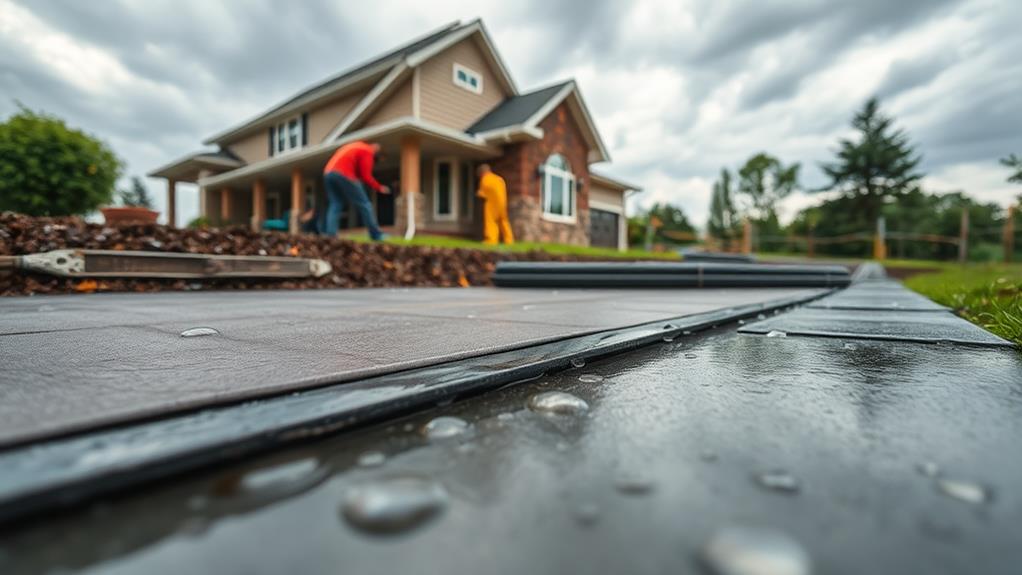
Modern waterproofing techniques have evolved to address the vulnerabilities exposed by changing weather patterns and environmental conditions. These advanced methods offer enhanced protection against water infiltration and structural damage.
Exterior waterproofing membrane systems are now widely used, featuring elastomeric coatings that form a seamless barrier around the foundation. These membranes are often reinforced with fiberglass or polyester fabrics for added durability.
Crystalline waterproofing compounds have gained popularity for their ability to penetrate concrete and form water-resistant crystals within the pores and capillaries.
Drainage systems have also improved, with the introduction of dimpled membrane drainage boards that create an air gap between the soil and foundation wall, allowing water to flow freely to the footing drains. French drains and sump pump systems are now more efficient, utilizing advanced materials and smart technology for improved performance.
Injection methods have become more sophisticated, allowing for the repair of existing cracks and joints without extensive excavation. Polyurethane and epoxy injection systems can effectively seal leaks and strengthen weakened areas of the foundation.
These modern techniques, when properly implemented, significantly enhance a foundation's resistance to water damage and structural issues caused by moisture intrusion.
Exterior Drainage Solutions
Effective exterior drainage solutions play a crucial role in protecting foundations from water damage. Recent storm patterns have highlighted the importance of implementing robust systems to divert water away from a building's foundation. A comprehensive approach typically includes a combination of techniques designed to manage surface runoff and subsurface water.
Grading the landscape away from the foundation is a fundamental step, ensuring that water naturally flows away from the structure. This is often complemented by the installation of gutters and downspouts to channel roof runoff.
French drains, consisting of perforated pipes surrounded by gravel, can be installed around the perimeter of the foundation to collect and redirect groundwater. For areas with high water tables or persistent moisture issues, a more advanced solution may involve installing an exterior drainage mat along the foundation walls, coupled with a sump pump system to actively remove accumulated water.
In some cases, the addition of swales or dry creek beds can further enhance water management by providing designated pathways for excess runoff. Regular maintenance of these systems is crucial to ensure their continued effectiveness in protecting the foundation from water-related damage.
Interior Moisture Control Strategies
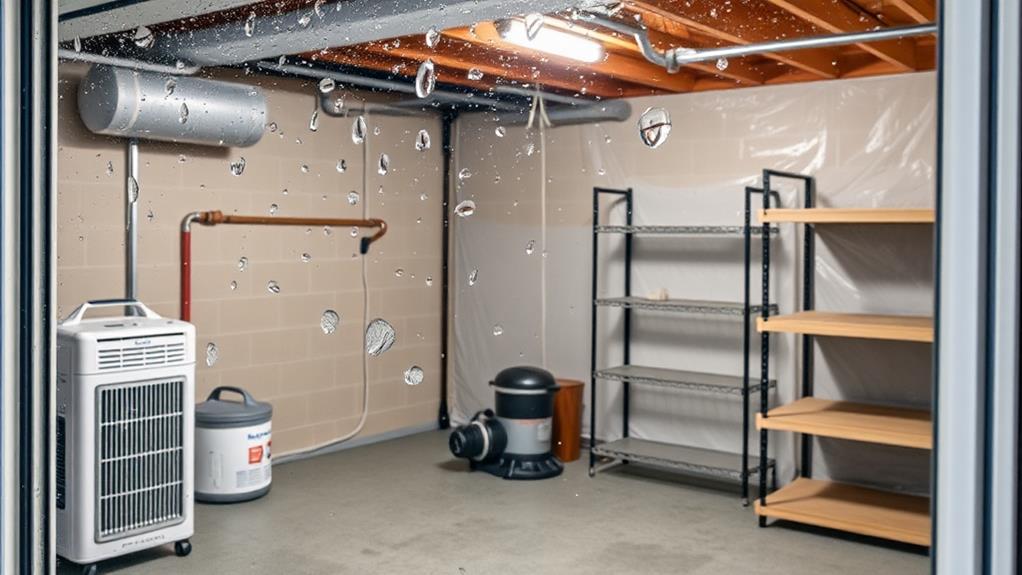
Interior moisture control strategies complement exterior waterproofing measures to create a comprehensive defense against water damage in foundations. These strategies focus on managing moisture levels inside the home to prevent condensation and water accumulation in basement areas.
One key approach is proper ventilation. Installing dehumidifiers and ensuring adequate air circulation helps reduce humidity levels, discouraging mold growth and moisture buildup. Sealing air leaks in walls, floors, and around windows and doors also prevents warm, moist air from entering cooler basement spaces and condensing.
Applying waterproof coatings or sealants to interior foundation walls provides an additional barrier against moisture penetration. These products can be particularly effective in older homes with porous concrete or masonry foundations.
Proper grading of basement floors, coupled with the installation of a sump pump system, helps manage any water that does enter the space. Regular maintenance of these systems, including checking for clogs and ensuring proper operation, is crucial for long-term effectiveness.
Lastly, selecting appropriate materials for basement finishing, such as moisture-resistant drywall and mold-resistant insulation, can further enhance interior moisture control and protect against potential water damage.
Sump Pump Installation and Maintenance
A cornerstone of basement waterproofing, sump pump installation and maintenance play a critical role in protecting foundations from water damage. These systems are designed to collect and redirect excess water away from the foundation, preventing flooding and moisture accumulation.
When installing a sump pump, proper placement is crucial. The sump pit should be positioned at the lowest point of the basement, typically in a corner. The pit must be deep enough to accommodate the pump and allow for adequate water collection. A professionally installed system includes a check valve to prevent backflow and a battery backup for continuous operation during power outages.
Regular maintenance ensures optimal performance. This includes:
- Quarterly testing of the pump by pouring water into the pit
- Annual cleaning of the pit and pump to remove debris
- Inspecting and replacing the check valve as needed
- Verifying the functionality of the float switch
- Checking the battery backup system and replacing batteries every 2-3 years
Landscaping for Water Management

Proper landscaping serves as a crucial first line of defense in managing water around your foundation. Effective grading ensures that water flows away from your home, preventing pooling near the foundation. Aim for a slope of at least 6 inches over a distance of 10 feet from the house. Install gutters and downspouts to direct rainwater away from the foundation, extending downspouts at least 5 feet from the house.
Incorporate water-absorbing plants and trees strategically around your property to help reduce runoff. Native species are often best suited for local climate conditions and can effectively manage water. Create rain gardens in low-lying areas to capture and filter excess water. Use permeable materials for driveways and walkways to allow water to seep into the ground rather than run off.
Consider installing French drains or dry wells to collect and redirect water away from your foundation. Regularly maintain your landscaping by cleaning gutters, trimming vegetation, and inspecting for erosion or settling. Address any issues promptly to prevent water from accumulating near your foundation. By implementing these landscaping strategies, you can significantly reduce the risk of water damage to your home's foundation.
Foundation Crack Repair Methods
While effective landscaping can prevent water issues, addressing existing foundation cracks is equally important for comprehensive waterproofing. Foundation cracks can allow water infiltration, leading to structural damage and indoor moisture problems. Several methods exist for repairing these cracks, depending on their size and severity.
For hairline cracks less than 1/8 inch wide, epoxy injection is often the preferred method. This involves injecting low-viscosity epoxy into the crack, which hardens to form a waterproof seal.
For wider cracks, hydraulic cement can be used to fill the void and stop active leaks. This quick-setting material expands as it cures, ensuring a tight seal.
Polyurethane foam injection is another effective method, particularly for moving cracks. The foam expands to fill the crack and remains flexible, accommodating minor foundation movements.
For more severe cases, carbon fiber reinforcement may be necessary. This involves applying carbon fiber strips over the crack, which are then sealed with epoxy resin.
In cases of extensive damage, full foundation waterproofing may be required, involving excavation and the application of external waterproof membranes or coatings.
Waterproof Coatings and Sealants

Waterproof coatings and sealants serve as crucial components in the comprehensive protection of foundations against water intrusion. These products create a barrier that prevents moisture from penetrating the concrete or masonry surfaces, effectively safeguarding the structural integrity of the foundation.
Various types of waterproof coatings are available, including cementitious, acrylic, and polyurethane-based formulations. Each offers distinct advantages depending on the specific requirements of the foundation and environmental conditions. Cementitious coatings provide excellent durability and can withstand hydrostatic pressure, while acrylic coatings offer flexibility and UV resistance. Polyurethane coatings are known for their superior elasticity and ability to bridge small cracks.
Sealants, on the other hand, are typically used for filling joints, cracks, and gaps in the foundation. Silicone and polyurethane sealants are popular choices due to their longevity and ability to maintain flexibility in varying temperatures. When applying coatings or sealants, proper surface preparation is essential to ensure optimal adhesion and performance. This may involve cleaning, repairing existing damage, and addressing any underlying moisture issues. Regular inspection and maintenance of these protective layers are crucial for long-term effectiveness in waterproofing the foundation.
Climate-Resilient Foundation Design
Climate-resilient foundation design has become increasingly important as extreme weather events and changing environmental conditions continue to challenge traditional construction methods. This approach integrates strategies to withstand intense rainfall, flooding, and soil instability caused by climate change.
Key elements of climate-resilient foundation design include elevated foundations, reinforced footings, and improved drainage systems. Elevated foundations raise the structure above potential flood levels, while reinforced footings provide enhanced stability against soil erosion and shifting. Improved drainage systems, such as French drains and sump pumps, efficiently manage excess water around the foundation.
Materials selection is crucial in climate-resilient design. Water-resistant concrete mixes, corrosion-resistant reinforcements, and moisture-barrier membranes are incorporated to enhance durability and longevity. Additionally, flexible foundation designs that can accommodate soil movement and settlement are becoming more common.
Site-specific considerations are essential in climate-resilient foundation design. Factors such as local climate projections, soil composition, and historical weather patterns inform the design process. This tailored approach ensures that foundations are equipped to handle both current and future environmental challenges, ultimately protecting the structure and its occupants from climate-related risks.
Frequently Asked Questions
How Much Does Professional Foundation Waterproofing Typically Cost?
Professional foundation waterproofing costs typically range from $5,000 to $15,000 for an average-sized home. Factors influencing price include foundation size, depth, soil conditions, and chosen waterproofing method. Severe cases may require more extensive work, increasing costs significantly.
Can I Waterproof My Foundation Myself, or Should I Hire Professionals?
While DIY foundation waterproofing may seem cost-effective, it's a complex task that requires expertise. Professional waterproofing is highly recommended to ensure proper application, address potential issues, and provide long-lasting protection for your home's structural integrity and value.
How Long Does Foundation Waterproofing Last Before Needing Replacement or Maintenance?
The lifespan of foundation waterproofing typically ranges from 10 to 20 years, depending on the quality of materials and installation. Regular maintenance can extend its effectiveness. Factors like soil conditions and climate may impact longevity, necessitating earlier intervention.
Are There Specific Insurance Considerations for Homes With Waterproofed Foundations?
Zounds! Insurance considerations for waterproofed foundations are vital. Many policies offer discounts for preventative measures. However, coverage may vary depending on the waterproofing method used. Homeowners should consult their insurance providers for specific details and potential benefits.
What Are Signs That My Existing Foundation Waterproofing May Be Failing?
Signs of failing foundation waterproofing include water seepage, dampness, or mold in basements, cracks in walls or floors, musty odors, efflorescence (white powdery deposits), and peeling paint or wallpaper. Exterior indicators may include soil erosion around the foundation.
Conclusion
Recent storm patterns have underscored the critical importance of comprehensive foundation waterproofing. While some may argue that traditional methods suffice, evolving climate conditions demand innovative approaches. By implementing modern techniques, from exterior drainage solutions to climate-resilient designs, homeowners can significantly mitigate water damage risks. Proactive foundation protection not only preserves structural integrity but also enhances property value. As extreme weather events become more frequent, adapting waterproofing strategies is no longer optional but essential for long-term home resilience and sustainability.
